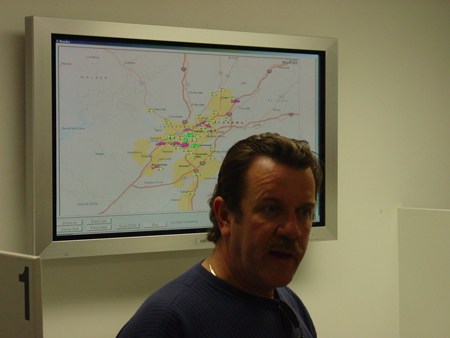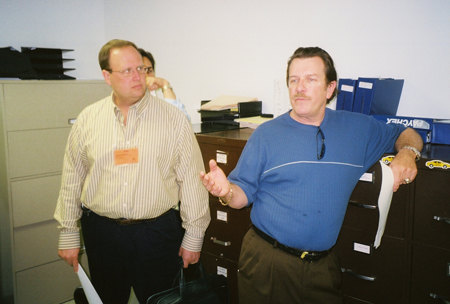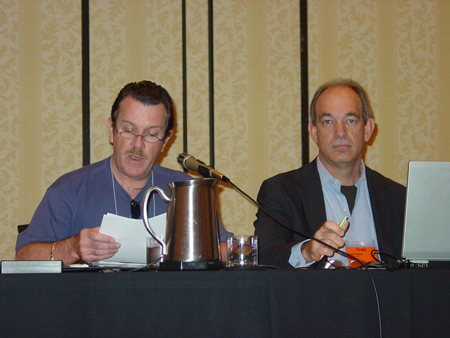TLPA
IN-VEHICLE CAMERAS
The
highest attended TLPA educational breakout sessions at the recent TLPA
Annual Convention in Las Vegas was on the subject of In-Vehicle Camera
Systems. Ells Houston, President Birmingham Yellow Cab, Birmingham,
Alabama moderated the session. Ellis’ opening remarks follow:

“For
a point of reference, I operate taxicab and paratransit vehicles in
Birmingham, Alabama and Little Rock, Arkansas. With me on the panel
are some of TLPA’s most distinguished members:
- Jeb
Corey from Charleston, West Virginia. Jeb is TLPA’s youngest
board member;
- One
of our esteemed past presidents, Judy Swystun, from Norfolk, Virginia;
and
- John
Doherty, a past recipient of TLPA’s prestigious Paratransit
Operator of the Year award, from Milwaukee, Wisconsin.
I look forward to us having a very informative and vibrant discussion
on camera systems this morning in the short time we are allotted. In
line with this, each of our panel members is going to spend a few minutes
sharing their experience with you on this subject matter from several
different viewpoints.
Before
we begin, I would like for the audience to note that while none of the
members on this panel dismiss the importance and value of digital still
shot cameras from strictly a driver security prospective, most of our
panel discussion will focus on duel-lens-multi-function camera technology
with g-force activated capabilities. “
Jeb
Corey, C & H Taxi Company, Charleston, West Virginia, one of the
longest users of this technology in the taxicab industry, showed several
film clips that showed the benefits of his company’s g-force activated
duel lens cameras from both a claims’ prospective and a driver
security prospective. Jeb also delighted the audience with several humorous
film clips of driver events.
Judy
Swystun, Black & White Cars, Norfolk, Virginia, talked about her
company moving from digital cameras to g- force activated cameras. One
of the facts Judy conveyed to the audience was that her claims expense
year to date was about 25 percent less on her fleet with the new cameras
opposed to her fleet without cameras. Judy also talked about the driver
safety and security aspect of the cameras
John
Doherty, Transit Express, Milwaukee, Wisconsin, discussed how the new
camera technology was benefiting his paratransit company by modifying
the behavior of his company’s drivers, and therefore reducing
both their claims and maintenance expense. John also showed some film
clips of how he was using the new camera technology to help his company
reconstruct accidents.
Ellis
Houston concluded the session by conveying to the audience his view
based on a six month investigation he recently completed on where in-vehicle
camera system technology is headed in the future. He stated:
“I’m
going to spend a few minutes talking about where I believe this camera
system technology is headed.
First,
I want to convey that I was one of our industry’s foremost skeptics
of this technology. I saw nothing but a downside until I purchased and
field-tested 10 of these g-force activated camera units.
Ladies
and gentlemen, it was only a matter of days after my testing began before
I was no longer a skeptic, but a shopper for 200 plus units to install
in my companies’ vehicles. As a shopper, I spent the first six
months of this year investigating this technology as head of a loose
knit coalition of taxi, limousine and paratransit companies whose goals
were the same as mine — to find the best g-force duel lens camera
product on the market at a price we felt was appropriate for this type
of technology.
When
I started my investigation, I only knew of one camera vendor with a
duel lens, g-force activated camera product. When I completed my investigation
a few months back and placed a camera order for my companies I had looked
at and/or field-tested approximately 15 different camera systems that
were either in the marketplace, or were in various stages of development.
During
this process, I came to the conclusion that there is currently not a
one-shoe-fits all camera system on the market today for the taxicab,
paratransit and limousine industry. The reason being is we all want
something a little different.
For
example,
- a
taxicab operator may want a system without audio that films forward
and backward, including all the occupants in the vehicle;
- a
limousine operator may want a system that films forward and backward,
including the driver, but not any passengers; and
- a
paratransit operator may want a system with audio that films forward
and backward.
With that said, I did look at some camera systems in development which
I do believe will have the capabilities to serve the future needs of
the entire for-hire transportation industry. These camera systems of
the future will not be stand alone, but will become an add on to a full
blown in-vehicle mini computer system.
Ladies
and gentlemen, an easily programmable computer in the vehicle is going
to open up endless possibilities for our industry. Not only will we
be able to customize a camera system for our specific individual needs,
we will be able to:
- extract
braking, speed and idle time, etc. from a vehicle’s diagnostic
port;
- we
will be able to add vehicle collision avoidance sensors;
- we
will be able to easily add vehicle GPS and Mapping software; and
- we
will be able to easily connect to any public service network, such
as Verizon, Cingular, etc. for remote downloading of data and/or to
provide in-vehicle internet client services.
I
could continue on but I believe you get the picture.
Finally,
ladies and gentlemen, when I placed my order for a camera system I did
so knowing the system I chose today may not be the one I choose to use
a couple of years down the road because of the many technical advances
I see forthcoming. For this reason, I would be very hesitant to endorse
any specific camera system vendor.
However,
I believe I can speak for all of the members of this panel in stating
we encourage TLPA’s membership to support the vendors that support
our association by purchasing booth space and displaying their products
and services at our trade shows.”


Harold
Morgan, TLPA Director of Research & Education, submitted this article.
© 2015 TLC Magazine Online, Inc. |